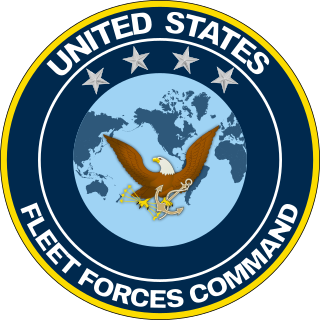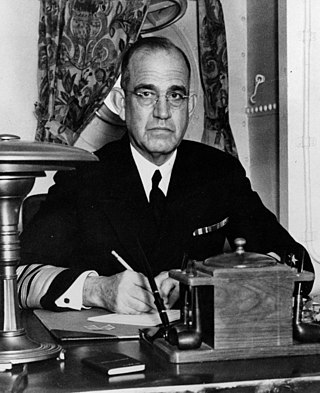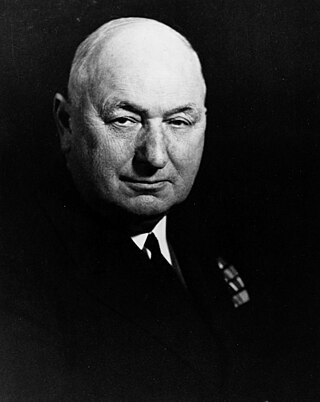Related Research Articles

The United States Pacific Fleet (USPACFLT) is a theater-level component command of the United States Navy, located in the Pacific Ocean. It provides naval forces to the Indo-Pacific Command. Fleet headquarters is at Joint Base Pearl Harbor–Hickam, Hawaii, with large secondary facilities at Naval Air Station North Island, California.

Husband Edward Kimmel was a United States Navy Two-star admiral who was the commander in chief of the United States Pacific Fleet (CINCPACFLT) during the Japanese attack on Pearl Harbor. He was removed from that command after the attack, in December 1941, and was reverted to his permanent two-star rank of rear admiral due to no longer holding a four-star assignment. He retired from the Navy in early 1942. The United States Senate voted to restore Kimmel's permanent rank to four stars in 1999, but President Clinton did not act on the resolution, and neither have any of his successors.

The United States Fleet Forces Command (USFF) is a service component command of the United States Navy that provides naval forces to a wide variety of U.S. forces. The naval resources may be allocated to Combatant Commanders such as United States Northern Command (USNORTHCOM) under the authority of the Secretary of Defense. Originally formed as United States Atlantic Fleet (USLANTFLT) in 1906, it has been an integral part of the defense of the United States of America since the early 20th century. In 2002, the Fleet comprised over 118,000 Navy and Marine Corps personnel serving on 186 ships and in 1,300 aircraft, with an area of responsibility ranging over most of the Atlantic Ocean from the North Pole to the South Pole, the Caribbean Sea, Gulf of Mexico, and the waters of the Pacific Ocean along the coasts of Central and South America.

Ernest Joseph King was a fleet admiral in the United States Navy who served as Commander in Chief, United States Fleet (COMINCH) and Chief of Naval Operations (CNO) during World War II. As COMINCH-CNO, he directed the United States Navy's operations, planning, and administration and was a member of the Joint Chiefs of Staff. He was the United States Navy's second most senior officer in World War II after Fleet Admiral William D. Leahy, who served as Chief of Staff to the Commander in Chief.

Harold Rainsford Stark was an officer in the United States Navy during World War I and World War II, who served as the 8th Chief of Naval Operations from August 1, 1939 to March 26, 1942.

Vice Admiral William Satterlee Pye was a U.S. Navy officer who served during World War I and World War II, but never saw combat action. His last active-duty appointment was as President of the Naval War College, in 1942–1946. His awards included the Navy Cross for his distinguished service as a staff officer during World War I.

Carlisle Albert Herman Trost was a United States Navy officer who served as the 23rd Chief of Naval Operations (CNO) and a member of the Joint Chiefs of Staff from July 1, 1986 to June 29, 1990. He oversaw the Navy during the end of the Cold War, and the preparations for the Gulf War of 1991. He retired from active naval service on July 1, 1990, following completion of a four-year term as CNO.

James Otto Richardson was an admiral in the United States Navy who served from 1902 to 1947.

Admiral Richmond Kelly Turner, commonly known as Admiral Kelly Turner, served in the United States Navy during World War II, and is best known for commanding the Amphibious Force during the campaign across the Pacific. Admiral Turner was responsible for the creation of the Underwater Demolition Teams (UDT) that were an early precursor to the United States Navy SEALs.

Commander, U.S. Fleet Forces Command (COMUSFF/COMFLTFORCOM) is the title of the United States Navy officer who serves as the commanding officer of the United States Fleet Forces Command. The U.S. Fleet Forces Command was originally established in 1905 as the U.S. Atlantic Fleet and as a two-star rear admiral's billet; the position has been held by a four-star admiral since March 10, 1915. The 45th, and current, commander of U.S. Fleet Forces Command is Admiral Daryl L. Caudle.

Charles Philip Snyder was a four-star admiral in the United States Navy who served as the U.S. Navy's first Naval Inspector General during World War II.

Admiral James Fife Jr. was a United States Navy admiral who was promoted to four-star rank after retirement as a "tombstone admiral".

Edward Clifford Kalbfus, nicknamed "Old Dutch", was a four-star admiral in the United States Navy who was commander of the Battle Force of the United States Fleet from 1938 to 1939 and President of the Naval War College from 1934 to 1936 and 1939 to 1942.

Admiral Frederick Joseph Horne was a four-star admiral in the United States Navy. As the first Vice Chief of Naval Operations, he directed all Navy logistics during World War II.

The Southeast Pacific Area was one of the designated area commands created by the Combined Chiefs of Staff in the Pacific region during World War II. It was responsible to the Joint Chiefs of Staff via the Commander-in-Chief of the United States Navy (COMINCH), Admiral Ernest King. Rear Admiral Abel T. Bidwell, former commander of Cruiser Division Three, commanded the Southeast Pacific Area during the first months of the war.
References
- ↑ – via Wikisource.
- ↑ Norman Polmar, p.33
- ↑ King, Ernest J.; Whitehill, Walter Muir (1952). Fleet Admiral King A Naval Record (First ed.). New York: W. W. Norton & Company, Inc. p. 227.
- ↑ "Executive Orders, Franklin D. Roosevelt, 1941". National Archives. 18 December 1941. Retrieved 22 January 2009.
Executive Order 8984, Prescribing the Duties of the Commander in Chief of the United States Fleet and the Co-operative Duties of the Chief of Naval Operations, Signed: December 18, 1941
- ↑ Borneman, Walter R. (2012). The Admirals: Nimitz, Halsey, Leahy and King – The Five-Star Admirals Who Won the War at Sea. New York, NY: Little, Brown and Company. ISBN 978-0-316-09784-0.
- ↑ Executive Orders Disposition Tables; Truman, 1945, National Archives and Records Administration, 2018-07-21.